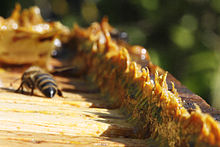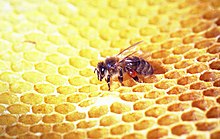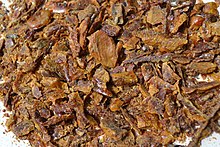Propolis

The Propolis ( Greek προ per , German , before ' and πόλις pólis , City' because of the frequent occurrence of the flight holes of hives ), also advance , Stopfwachs , propolis , Bienenleim , propolis , propolis or Kittwachs called, is one of bees produced resinous mass with antibiotic , antiviral and antifungal effects. Propolis is a mixture of many different substances, the composition of which can vary greatly.
Since the insects live together in a beehive in a confined space at around 35 ° C and high humidity , there are ideal conditions for disease to spread. Propolis therefore serves the bees to seal small openings, crevices and cracks and at the same time to inhibit or kill bacteria , fungi and other microorganisms introduced or present in the hive . For this purpose, various surfaces, such as the inside of the honeycomb cells for the brood, are covered with a wafer-thin propolis film. Foreign bodies or rubbish that are present in the beehive and cannot be removed by the bees are also encapsulated with this substance.
Origin and composition
The raw material is collected by honey bees as a resinous substance on the buds and partly on the wounds of various trees (in Europe mainly birch , beech , alder , spruce , poplar , horse chestnut and elm ) (about 55% natural resin and pollen balm ). Further processed, enriched with around 30% wax , around 5% pollen , around 10% essential oils from the flower buds and salivary secretions ( ferments ), it is a building material that is sticky at hive temperature, which is often still contaminated with parts of bees and the smallest pieces of wood.
Resin and pollen balm from propolis are rich in flavonoids such as chrysin, galangin , pinocembrin, pinobanksin acetate, prenyl flavonoid, isonymphaeol-B, nymphaeol-A, nymphaeol-B and nymphaeol-C. Gum, phenols ( cinnamic acid , coumaric acid, caffeic acid , ferulic acid , isoferulic acid) and their esters as well as polysaccharides are also contained in propolis.
Propolis is most commonly brought into the beehive by bees in autumn ; this depends on the local availability of resin in the tree population. A colony of bees can bring in between 50 and 500 g of propolis per year.
Extraction
The beekeeper can scrape off the propolis at various points of the beehive ( magazine hive ) where cracks or similar have been cemented by the bees. Propolis can be obtained in a more targeted manner by placing a special fine-meshed plastic grid. The bees cement these annoying spaces. The grid is then removed and placed in the freezer. At these low temperatures, propolis is very brittle and jumps off the plastic grid when it is bent slightly.
The raw material obtained in this way can then be further processed by dissolving it in high-percentage alcohol and then filtering out impurities.
properties
Propolis is a brownish-yellow, resinous mass with an aromatic odor. It only partially dissolves in water and in ethanol . As a mixture of natural substances, propolis has a variety of effects.
Antioxidant effect
Propolis is said to counteract oxidative stress . In animal experiments on rats, the binding of reactive oxygen species (“radical scavengers”) by propolis was shown. For this purpose, an antioxidant effective prenylated flavonoids blamed.
Antimicrobial and virostatic effect
The antibiotic effects of aqueous and alcoholic propolis extracts as well as individual propolis ingredients were proven in the agar dilution test and agar diffusion test against gram-positive and gram-negative germs. In addition, an antiviral effect against rhinoviruses and herpes viruses was found in the plaque reduction test. Propolis has a growth-inhibiting effect on Candida albicans and skin fungi ( dermatophytes ).
In animal experiments on mice , propolis showed bactericidal , antimycotic and virostatic effects. Some of the effects are believed to be comparable to those of the flavonoids . The antibacterial effect is pinocembrin and Galangin, antifungal and antiviral effect pinocembrin and caffeic acid - esters - particularly the caffeic acid 2-phenylethyl ester - attributed.
Wound healing promoting effect
Propolis is said to promote wound healing. For the promotion of granulation are apigenin and luteolin blamed.
Cytotoxic properties
Propolis has a cytotoxic effect. In animal experiments on mice, for example, it was able to inhibit the growth of implanted cancer tumors.
Allergenicity
Propolis acts as a contact allergen due to the various caffeic acid derivatives it contains ( caffeic acid (1,1-dimethylallyl ester) and other caffeic acid esters), benzyl cinnamate and benzyl salicylate . Both when used as a medicinal product and when used externally in cosmetic products, allergic reactions have been described in connection with propolis (contact). Isolated cases of suspected allergic reactions after oral intake have also been reported.
use
Preservation
In ancient Egypt , propolis was used in the embalming of mummies .
Surface coating
Propolis can be used to make wood glaze . Propolis was also used to make violin varnish for Cremonese violins .
Health related use
Propolis was and is used therapeutically in a wide range of areas of application, for which various dosage forms such as tinctures, ointments, mouthwashes, lozenges, nasal sprays and capsules are used.
Externally, propolis is used preventively and therapeutically for irritations, inflammations and injuries to the skin (sunburn, minor cuts or abrasions, eczema , medical foot care) and mucous membranes (medical dental and oral hygiene, minor injuries in the oral cavity, aphthae , inflammation of the anal mucosa ). Ethanol sprays and lozenges are used to protect against infections and to support the treatment of mild inflammation of the mucous membranes in the mouth and throat. Propolis is also used in care products for skin and hair. Propolis is used locally in rubs and ointments to relieve rheumatic complaints.
Internally, propolis is traditionally used to "strengthen" the immune system and prevent colds of the lower respiratory tract ( bronchitis ). However, there are no scientifically meaningful indications of a possible infection-preventive effect. Therefore, related disease-related statements in connection with the intake of food supplements and with the support of the health of the respiratory tract, the intestines, the liver, the immune system, normal blood circulation, oral health and the antibacterial and antifungal effects (" health claims" ) are misleading ( § 11 , LFGB ) and not permitted.
The risk of developing partially severe allergies in contact with propolis is problematic . Contact dermatitis in particular has been reported. About 1–6% are allergic to propolis. Because of possible risks, pregnant and breastfeeding women should not take propolis.
literature
- Manfred Neuhold: The bees medicine cabinet . Stocker, Graz / Stuttgart 2006, ISBN 3-7020-1132-3 .
- Pavlina Pocinkova: Apitherapy: The healing power of honey & Co. 2nd, revised edition. Ehrenwirth, Munich 1999, ISBN 3-431-04010-1 , pp. 34-42.
- Dirk Rohwedder, Bent H. Havsteen: Propolis, the stuff of health; an active ingredient of nature. BTV-Taschenbuch-Verlag, Berlin 1987.
- Geert Staemmler: Apprenticeship as a beekeeper. Introduction and guide for beekeepers. Ulmer, Stuttgart 1990, ISBN 3-8001-1076-8 , pp. 138-142.
- Paul Uccusic: Bee products: Doctor Biene - Your healing power and application in the art of healing. Heyne, Munich 1990, ISBN 3-7205-1251-7 .
- Klaus Nowottnick: Propolis. Extraction - recipes - application; Healing power from the bee colony. Stocker, Stuttgart / Graz 2010, ISBN 978-3-7020-1285-4 .
- Vassya Bankova, Milena Popova, Boryana Trusheva: Propolis volatile compounds: chemical diversity and biological activity: a review. In: Chemistry Central journal. 2014, Volume 2, No. 8, p. 28. PMID 24812573 , PMC 4014088 (free full text) (overview of the numerous volatile ingredients).
- Murtala B. Abubakar, Wan Zaidah Abdullah, Siti Amrah Sulaiman, Boon Suen Ang: Polyphenols as Key Players for the Antileukaemic Effects of Propolis. In: Evidence-based complementary and alternative medicine. 2014, 371730. PMID 24772179 , PMC 3977507 (free full text) (To the ingredients from the group of polyphenols ).
- Werner Golder: Propolis - the cement resin of the bees in ancient literature. In: Würzburg medical history reports. No. 23, 2004, pp. 133-145.
Web links
- Health assessment of propolis and royal jelly . (PDF; 16 kB) Federal Institute
- Propolis . Agroscope
Individual evidence
- ↑ Shahin Gavanji, Behrouz Larki: Comparative effect of propolis of honey bee and some herbal extracts on Candida albicans. In: Chinese Journal of Integrative Medicine. 2015, pp. 1–7. doi: 10.1007 / s11655-015-2074-9 .
- ↑ S. Kumazawa et al .: A new prenylated flavonoids from propolis collected in Okinawa, Japan. In: Bioscience, Biotechnology, and Biochemistry . Volume 68, No. 1, January 2004, pp. 260-262. PMID 14745198 .
- ↑ a b c Elke Langner: Phytochemical and microbiological investigations of propolis of different origins as a contribution to the knowledge of the active principles in propolis. Dissertation . Shaker Verlag ( BoD ), Berlin 1995.
- ↑ T. Dingermann, K. Hiller, G. Schneider, I. Zündorf: Schneider drug drugs. 5th edition. Elsevier 2004, ISBN 3-8274-1481-4 , p. 599.
- ↑ Gokhan Eraslan, Murat Kanbur, Sibel Silici: Evaluation of propolis effects on some biochemical parameters in rats treated with sodium fluoride. In: Pesticide Biochemistry and Physiology. Volume 88, No. 3, July 2007, pp. 273-283.
- ↑ R. Padmavathi et al .: Therapeutic effect of paclitaxel and propolis on lipid peroxidation and antioxidant system in 7,12 dimethyl benz (a) anthracene-induced breast cancer in female Sprague Dawley rats. In: Life Sciences . Volume 78, No. 24, May 8, 2006, pp. 2820-2825. PMID 16375927 .
- ↑ T. Shimizu et al .: Anti-influenza virus activity of propolis in vitro and its efficacy against influenza infection in mice. In: Antiviral chemistry & chemotherapy. Volume 19, No. 1, 2008, pp. 7-13. PMID 18610553 .
- ↑ I. Kosalec et al .: flavonoid analysis and antimicrobial activity of Commercially available propolis products. In: Acta Pharmaceutica . Volume 55, No. 4, December 2005, pp. 423-430. PMID 16375832 .
- ↑ TP Cushnie, AJ Lamb: Antimicrobial activity of flavonoids In: International Journal of Antimicrobial Agents . Volume 26, No. 5, November 2005, pp. 343-356. PMID 16323269 ; Erratum. In: Int J Antimicrob Agents. Volume 27, No. 2, February 2006, p. 181.
- ↑ a b c Entry on propolis. In: Römpp Online . Georg Thieme Verlag, accessed on June 8, 2015.
- ↑ a b E. Teuscher: Biogenic medicines. 5th edition. Wissenschaftliche Verlagsgesellschaft, 1997, ISBN 3-8047-1482-X , p. 199.
- ^ MN Draganova-Filipova et al .: Effects of propolis and CAPE on proliferation and apoptosis of McCoy-Plovdiv cell line. In: Folia medica (Plovdiv). Volume 50, No. 1, 2008, pp. 53-59. PMID 18543789 .
- ↑ MS Weng: Propolin H from Taiwanese propolis induces G1 arrest in human lung carcinoma cells. In: Journal of Agricultural and Food Chemistry . Volume 27, No. 55 (13), June 2007, pp. 5289-5298. PMID 17530771 .
- ↑ CN Chen, CL Wu, JK Lin: Apoptosis of human melanoma cells induced by the novel compounds propolin A and propolin B from Taiwenese propolis. In: Cancer Letters . Volume 8, No. 245 (1-2), Jan 2007, pp. 218-231. PMID 16516378 .
- ↑ Y. Aliyazicioglu et al .: Effects of Turkish pollen and propolis extracts on respiratory burst for K-562 cell lines. In: International Immunopharmacology . Volume 5, No. 11, October 2005, pp. 1652-1657. PMID 16039555 .
- ↑ Nada Oršolić et al .: Honey-bee products in prevention and / or therapy of murine transplantable tumors. In: Journal of the Science of Food and Agriculture. Volume 85, No. 3, 2005, p. 363, doi: 10.1002 / jsfa.2041 .
- ↑ a b c Assessment of propolis and royal jelly . In: Federal Institute for Risk Assessment (BfR) (Ed.): Updated opinion . No. 002/2009 , November 20, 2008 ( bfr.bund.de [PDF; 39 kB ; accessed on November 9, 2012]).
- ↑ Erwin von Grüner: Guitar and timbre. The way to a new conception of the guitar. In: Guitar & Lute. Volume 3, No. 5, 1981, p. 12.
- ↑ Werner Golder: Propolis - the putty resin of bees in ancient literature. In: Würzburg medical history reports. Volume 23, 2004, pp. 139-143.
- ↑ a b Bernd Kerschner: No effective evidence: Propolis against coronavirus, colds & flu. In: Medicine transparent . April 15, 2020, accessed July 8, 2020 .
- ↑ a b Propolis for a stronger immune system? In: consumer advice center . August 15, 2019, accessed July 8, 2020 .

